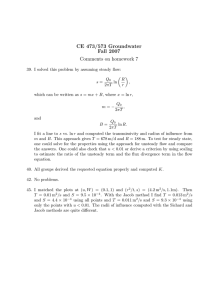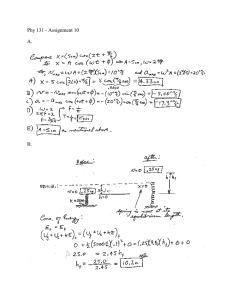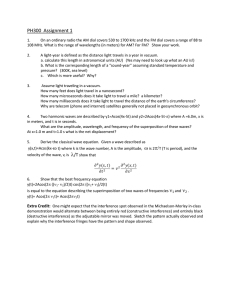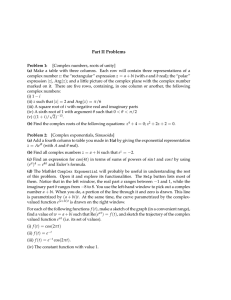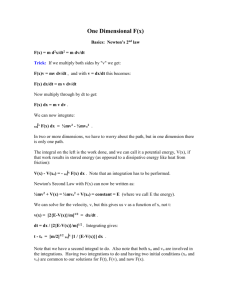Document 14285714
advertisement
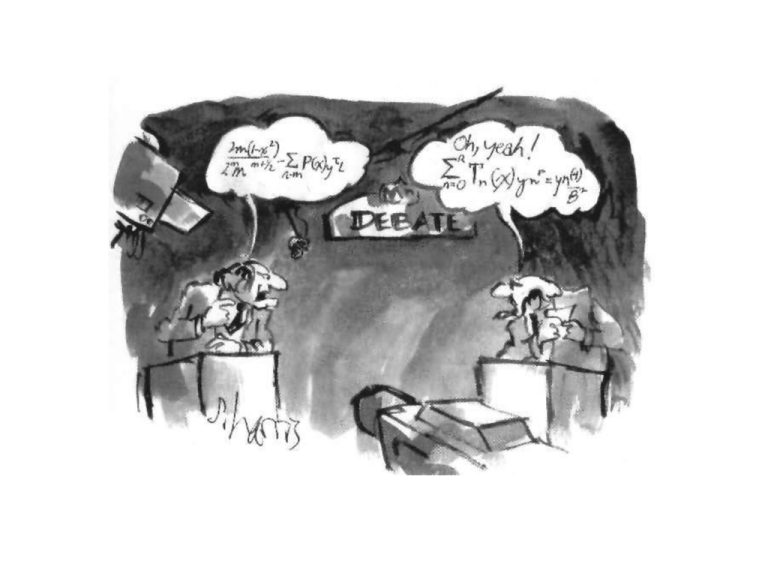
Chapter 11: Vibrations & Waves • First half of Chapter: Vibrations • Second half: Waves • Chapter 12: Sound waves. Sect. 11-1: Simple Harmonic Motion • Vibration Oscillation = back & forth motion of an object • Periodic motion: Vibration or Oscillation that regularly repeats itself. • Simplest form of periodic motion: Mass m attached to ideal spring, spring constant k (Hooke’s “Law”: F = -kx) moving in one dimension (x). – Contains most features of more complicated systems Use the mass-spring system as a prototype for periodic oscillating systems. Mass-Spring System • Mass-spring (no friction): Simplest form of periodic motion. Prototype for ALL vibrating systems • Restoring force obeys Hooke’s “Law”: F = -kx • A “simple harmonic oscillator” (SHO) • Undergoing “simple harmonic motion” (SHM) • Spring constant k: Depends on spring. Terminology & Notation • Displacement = x(t) • Velocity = v(t) • Acceleration = a(t) Constant!!!!!!! Constant acceleration equations from Ch. 2 DO NOT APPLY!!!!!!!!!!! • • • • Amplitude = A (= maximum displacement) One Cycle = One complete round trip Period = T = Time for one round trip Frequency = f = 1/T = # Cycles per second Measured in Hertz (Hz) A and T are independent!!! • Repeat: Mass-spring system contains most features of more complicated systems Use mass-spring system as a prototype for periodic oscillating systems. • Results we get are valid for many systems besides this prototype system. • ANY vibrating system with restoring force proportional to displacement (F = -kx) will exhibit simple harmonic motion (SHM) and thus is a simple harmonic oscillator (SHO). (whether or not it is a mass-spring system!) Mass-Spring System Vertical Mass-Spring System Sect. 11-2: Energy in the SHO • A Ch. 6 result: Compressing or stretching an ideal spring a distance x gives elastic PE: PE = (½)kx2 Total mechanical energy of SHO (massspring system) is conserved (a constant!) E = KE + PE = (½)mv2 + (½)kx2 = const – Assuming that friction is neglected! Energy conservation E = (½)mv2 + (½)kx2 = constant – The same throughout the motion • Mass is moving back & forth. Clearly x = x(t) The mass is speeding up & slowing down. Clearly v = v(t) E = (½)m[v(t)]2 + (½)k[x(t)]2 But E = const E(t) (independent of t!) E = (½)mv2 + (½)kx2 = constant • Conservation of KE + PE gives some properties: • At maximum x: At x = A, v = 0. Ex=A = (½)k(A)2 • At maximum v: At x = 0, v = v0 Ex=0 = (½)m(v0)2 • Somewhere in between (any x: -A x A). Ex = (½)mv2 + (½)kx2 • But E = constant Ex=A = Ex=0 = Ex = E E = (½)mv2 + (½)kx2 = constant • Using results that Ex=A = Ex=0 = Ex = E : (½)k(A)2 = (½)m(v0)2 = (½)mv2 + (½) kx2 • Relation between maximum x (x=A) & maximum v (v = v0): (½)k(A)2 = (½)m(v0)2 v0 = (k/m)½A • Velocity at any x: (½)k(A)2 = (½)mv2 + (½)kx2 v = v0 [1 - (x2/A2)]½ • Position at any v: (½)m(v0)2 = (½)mv2 + (½)kx2 (using above for v0): x = A[1 - (v2/v02)]½ Energy in Mass-Spring System Examples 11-4 & 11-5 Everything holds also for a vertical mass-spring system! Sect. 11-3: Period & Nature of SHM • Experiment: Period T of SHO does NOT depend on amplitude A! – T depends only on m & k • Derivation: Use motion in a circle & compare SHM to object rotating in circle. • Will give us T and expression for x(t). Circular Motion Comparison Similar triangles (v/v0) = [A2 - x2]½/(A) or v = v0 [1 - (x2/A2)]½ Same as for SHM! Projection on x-axis of motion of mass moving in a circle is the same as for a mass on a spring! • Period T for one revolution of circle Period T for SHO! • Circle, radius A, circumference 2πA, velocity v0. Mass goes once around (distance 2πA) in time T 2πA = v0T. Or, T = (2πA)/(v0) (1) • From energy discussion: (½)k(A)2 = (½)m(v0)2 v0 = (k/m)½ A (2) • Combining (1) & (2) gives: T = 2π(m/k)½ Period of SHO Period of SHO: T = 2π(m/k)½ – Agrees with experiment! – Independent of amplitude A Frequency f = (1/T) f = [1/(2π)](k/m)½ Angular frequency: ω = 2πf ω = (k/m)½ Sect. 11-3: x(t) • Find x(t) • From diagram: x = A cos(θ) • Mass rotating with angular velocity ω θ = ωt, ω = 2πf For SHO: x = Acos(ωt) = Acos(2πft) = Acos[(2πt)/(T)] • At t = 0, x = A. At t = T, x = A -A x A since -1 cos(θ) 1 x = Acos(ωt) = Acos(2πft) = Acos[(2πt)/(T)] • Assumes initial conditions that x = A at t = 0. Can show, if x is something else at t = 0, x(t) is still a sine or cosine function: If, at t = 0, x = 0, find: x = Asin(ωt) = Asin(2πft) = Asin[(2πt)/(T)] x(t), v(t), a(t) • For x = A at t = 0: x(t) = Acos(2πft) = Acos[(2πt)/(T)] – x is clearly a function of time x = x (t)! – Velocity and acceleration are ALSO functions of time: v = v(t) , a = a(t). Also sinusoidal functions. • v(t): We had v = v0 [1 - (x2/A2)]½. Put x(t) in this to get v(t): [1 - (x2/A2)] = 1 - cos2 [(2πt)/(T)] = sin2 [(2πt)/(T)] (Trig identity!) v(t) = v0 sin[(2πt)/(T)] Only for x = A at t = 0! • For x = A at t = 0: x(t) = Acos(2πft) = Acos[(2πt)/(T)] • a(t): We had (Hooke’s “Law”): F = -kx = -kx(t) We also have Newton’s 2nd Law: F = ma Combining gives a = a(t) = -(k/m) x(t) Using above form for x(t): a(t) = -(k/m) Acos[(2πt)/(T)] NOTE! The acceleration is a function of time and is NOT constant! a constant ! • For x = A at t = 0: a(t) = -(k/m) Acos[(2πt)/(T)] a = a(t) constant ! • NOTE!! This means that the 1 dimensional kinematic equations for constant acceleration (from Chapter 2) DO NOT APPLY!!!!!! • That is, THROW THESE AWAY FOR THIS CHAPTER!! THESE ARE WRONG AND WILL GIVE YOU WRONG ANSWERS!! Summary • We’ve shown that for x = A at t = 0: x(t) = Acos[(2πt)/(T)], v(t) = Asin[(2πt)/(T)] a(t) = -(k/m) Acos[(2πt)/(T)] • From conservation of energy: (½)k(A)2 = (½) m(v0)2 • Here: x(t) = Asin[(2πt)/(T)] v(t) = Acos[(2πt)/(T)] a(t) = -(k/m) Asin[(2πt)/(T)] x(t), v(t), a(t) : Functional forms depend on initial conditions!
